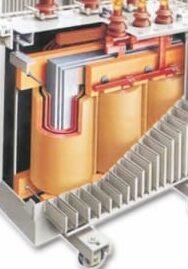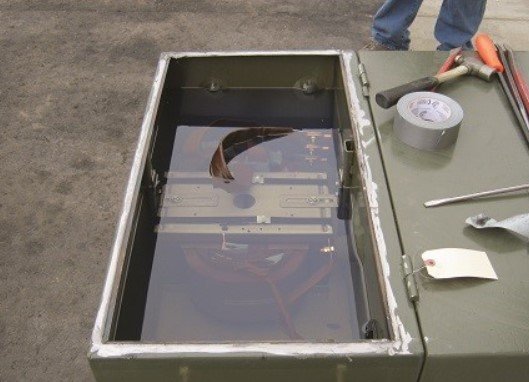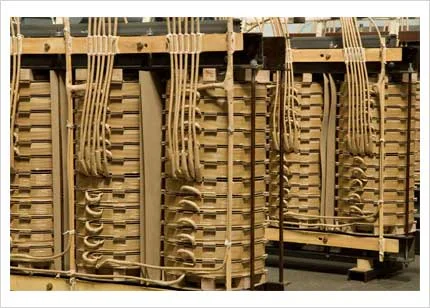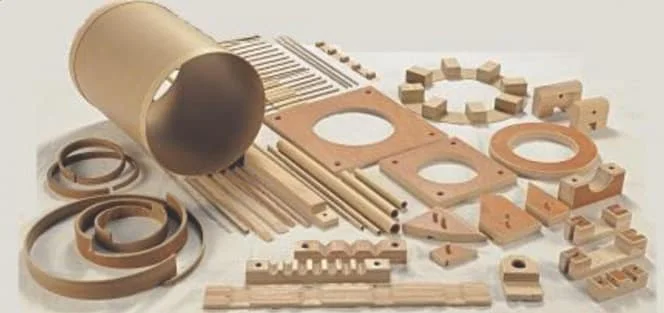Insulation materials are one of the most important elements in a transformer. They are used to electrically separate the conducting parts of a transformer from each other and from other components. Internal insulation failures are the major cause of transformer failures. This article intends to give you an overview of insulation materials used in transformers.
The following are the most important properties of an insulation materials used in transformers:
- Very high volume resistance or specific resistance.
- Low relative permittivity.
- High dielectric strength.
- Low dielectric loss.
Insulation materials used in transformers
Only those materials that satisfies the above-mentioned properties can be used as insulating material in transformers. The following are the most commonly used insulating materials are:
- Transformer oil
- Electrical grade paper
- Pressboard
- Wood and insulated wood
- Insulating tape
- Phenolic laminated paper base sheet
- Phenolic laminated cotton fabric sheet
Transformer oil
The transformer oil is the most important of all insulating materials used in transformers. It serves as an insulator as well as a coolant. Also, it protects the conducting parts from corrosion. Transformer oil, in general consists of four major compounds, namely, paraffin, naphthenes, aromatics and olefins. A good transformer oil must contain more saturated paraffin, fewer aromatics and naphthenes and zero olefins. Transformer oil is commonly known as hydrocarbon mineral oil.
Transformer oil also helps to identify the faults occurring in those conducting parts immersed in it. To sense those faults Buchholz relay is used in oil-immersed transformers rated over 500kVA. The colour of the oil helps to measure the intensity of the fault.
Typical characteristics of transformer oil
| Sl. No. | Characteristic | Typical requirements |
|---|---|---|
| 1 | Maximum density at 30°C | 0.89 g/cm3 |
| 2 | Maximum kinematic viscosity at 27°C | 27 cSt |
| 3 | Minimum interfacial tension | 0.04 N/m |
| 4 | Minimum flash point | 140°C |
| 5 | Maximum pour point | -6°C |
| 6 | Minimum breakdown voltage after filtration | 60 kV (rms) |
| 7 | Maximum dielectric dissipation factor at 90°C | 0.002 |
| 8 | Minimum resistivity at 90°C | 30 x 1012 ohm cm |
| 9 | Minimum resistivity at 27°C | 1500 x 1012 ohm cm |
| 10 | Permeabililty | 2.2 |
| 11 | Specific heat | 2.06 kJ/kg°C (0.0038) |
| 12 | Thermal conductivity | 0.12 W/m°C |
| 13 | Coefficient of expansion | 0.00078/°C |
| 14 | Mean density correction factor over the normal range of operating temperature | 0.00065/°C |
Electrical grade paper – kraft paper
Electrical grade paper or kraft paper is one of the cheapest and best insulation materials used in transformers. It should have high dielectric strength and it should be free from conducting particles. Kraft paper is made from unbleached softwood pulp manufactured by the sulphate process. Unbleached softwood is used because residual bleaching agents might alter its electrical properties. Kraft paper is used in the following parts.
- Kraft paper of medium air permeability is used for winding insulation.
- Medium air permeability Kraft paper is used in condenser core bushings.
- Kraft insulating paper of high permeability is used to insulate rectangular copper conductors.
- Crepe Kraft paper is used to insulate stranded copper cables.
The paper should have sufficient tensile strength to withstand the tension exerted on it when wrapped over the coils. It should also be able to withstand the thermal stresses during the service.
Pressboard
Like kraft paper, pressboard is also one of the widely used insulation material. They are nothing more than thick paper made by laying up a number of layers of paper at the wet stage of manufacture. Pressboard can be manufactured by either placing layers of paper at the wet stage without any bonding agent or by bonding individual boards using a suitable adhesive. Various forms of pressboards and their usage in transformer is listed below:
- Pressboard manufactured by moulding wet paper sheets is used for insulating ends of windings, insulation between windings and numerous other applications.
- Soft calendered pressboard is used as spacers, angle washers, yoke insulation etc.
- Soft pressboard is used for block washer, terminal-gear cleat and support, spacer, etc.
- Precompressed pressboard is used as warp, barrier, spacer, block,block washer, Top and bottom coil clamping ring,block, block washer, dovetail strip,spacer, etc
Properties of typical pressboard used in for transformer insulation
| Property | Parameter | units | LB 3.1A.1+ | LB 3.1A.2++ |
|---|---|---|---|---|
| Flexural Strength | MD | MPa | 115 | 130 |
| CMD | 105 | 120 | ||
| Compressibility | C | % | 2.7 | 2.2 |
| C rev | 83 | 84 | ||
| InternalPly Strength | Dry 23° C | MPa | 112 | 115 |
| Dry 120 °C retention | % | <79 | 73 | |
| Oiled 23 °C retention | 96 | 97 | ||
| Aged 23 °C retention | 94 | 97 | ||
| Apparent Density | g/cm8 | 1.24 | 1.30 | |
| MoistureContent | % | 7.4 | 3.5 | |
| Shrinkage | Thickness | % | 6.1 | 2.5 |
| MD | 0.4 | 0.2 | ||
| CMD | 0.6 | 0.3 | ||
| Oil Absorption | % | 12.5 | 10.01 | |
| AshContent | % | 0.5 | 0.9 | |
| Conductivity of aqueous extract | mS/m | 10.5 | 6.5 | |
| Electric strength in oil | kV/mm | 14.0 | 13.5 |
Wood
Compressed laminated wood is used in transformers for various purposes. They basically plywood made from wood veneer. Laminated wood is manufactured by cutting fine birch into veneers, and then gumming, stacking and hot pressing after dried. It has a very good dielectric strength, excellent oil absorption, low density, high mechanical strength and are highly durable.
Low-density unimpregnated densified laminated wood is used as cleat and support, core/yoke clamp,
wedge block, winding support block, sector, core to coil packing, etc. High density unimpregnated densified laminated wood is used for Coil clamping ring, block, cleat support, etc.
Insulating tapes
Cotton tapes, Cotton newar tapes, glass woven tape, Woven terylene tape and Polyester resin impregnated weftless glass tapes are used in transformers for banding transformer cores, bolts and other parts that requires higher dielectric strength.
Classification of insulating materials used in transformers
Insulation materials used in transformers are classified based on their temperature withstanding capacity. Below is the list of all classes of insulation used in transformers and examples.
| Insulation Class | Temperature limit | Insulating materials included |
|---|---|---|
| Y | 90 deg. Celsius | Cotton, silk, paper, and wood without impregnation. |
| A | 105 deg. Celsius | Laminated wood, varnished paper, and Cotton, silk, and paper when impregnation with natural resins, cellulose ester or insulating oil. |
| B | 130 deg. Celsius | Glass fiber, mica, and asbestos with suitable impregnation or coating substance. |
| C | Above 180 deg. Celsius | Glass, mica, asbestos, porcelain, and quartz with or without an inorganic binder or with silicon resins of high thermal stability. |
| E | 120 deg. Celsius | Synthetic resin enamel, paper and cotton bonded with formaldehyde. |
| F | 155 deg. Celsius | Glass fiber, mica, and asbestos with suitable impregnation or coating substance. |
| H | 180 deg. Celsius | Glass fiber, mica, and asbestos with silicon resins. |
This article is just an overview of insulating materials used in transformers. Insulating materials have numerous properties that make it difficult to bring together all details. If you are interested in learning insulating materials used in transformers in detail you can refer: https://onlinelibrary.wiley.com/doi/pdf/10.1002/9781119239970.ch1




total weight of insulating materials including solid insulating materials is required to know in 5MVA 33/11KV power transformer